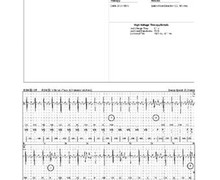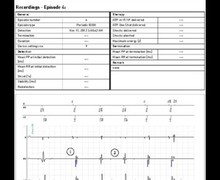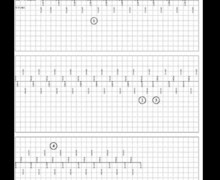SecureSense™ algorithm and T wave oversensing during ventricular pacing
Tracing
Manufacturer Abbott
Device ICD
Field Securesence
N° 8
Patient
This 67-year-old man presenting with dilated cardiomyopathy and left bundle branch block received a Unify Assura™ triple chamber ICD. Episodes of non-sustained RV oversensing were stored in the device memories.

Graph and trace
- VS2 markers present on the discrimination channel indicate that the noise counter was activated and previously incremented;
- atrial sensing and biventricular stimulation (AS-BV); post stimulation oversensing of the T wave is present on the bipolar channel and not on the discrimination channel;
- further post stimulation T wave oversensing on the bipolar channel; short cycles increment the noise counter; the next ventricular cycle is spontaneous (VS), as ventricular stimulation after the atrial event was not possible without exceeding the maximum tracking rate; the percentage of biventricular stimulation decreases;
- the noise counter is at 10 (10 short cycles on the bipolar channel; some cycles are not visible on this tracing) though the VF or VT counter is not filled; non-sustained ventricular oversensing (SNS) was diagnosed.
Other articles that may be of interest to you







This recipient of a cardiac resynchronization system responded imperfectly to treatment, with a percentage of stimulation limited to 70%. The episodes recorded revealed non-sustained RV oversensing, allowing the diagnosis of post-pacing T wave oversensing, explaining the intermittent loss of biventricular stimulation with alternans between stimulated and sensed ventricle. While the SecureSense™ algorithm diagnoses, it does not eliminate T wave oversensing and its stimulation consequences (inhibition of biventricular stimulation after sensing of the T wave). One of the advantages of the Abbott devices is the ability of programming differently the post-ventricular sensing and post-ventricular pacing settings, which require different adjustments. The change in post-pacing sensitivity enabled the correction of oversensing and the recovery of nearly 100% biventricular stimulation, which is mandatory for an optimal response to cardiac resynchronization.